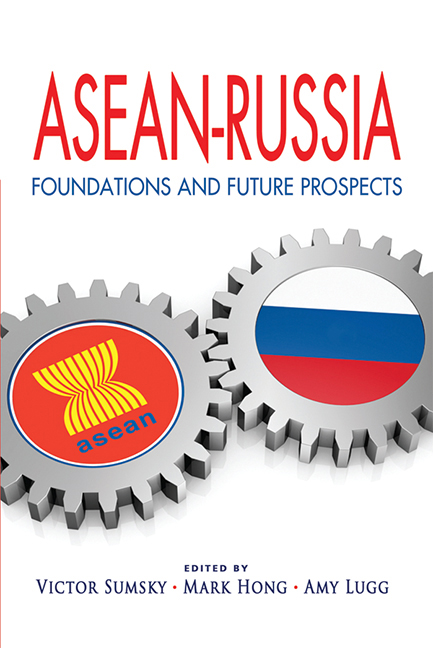Book contents
- Frontmatter
- Contents
- Foreword
- Preface
- About the Contributors
- Keynote Address
- Opening Remarks
- Keynote Address
- Introduction: Russia and the ASEAN Member States: Political and Economic Cooperation in Progress
- SECTION I WISEMEN'S VIEWS
- SECTION II GEOPOLITICS
- SECTION III BILATERAL RELATIONS
- SECTION IV Business and Economics
- SECTION V CULTURE AND EDUCATION
- Credentials of Literature
- A Sentimental Journey through ASEAN (in the Russian Way)
- Food for the Soul and the Stomach
- No Books about Singapore in Russian? Give me a Break! (An Editor's Note)
- National University of Singapore (NUS)-Russia: State of Collaboration
- Soft Power: A Comparison between Britain, France and Russia
- EPILOGUE
- Index
Food for the Soul and the Stomach
from SECTION V - CULTURE AND EDUCATION
Published online by Cambridge University Press: 21 October 2015
- Frontmatter
- Contents
- Foreword
- Preface
- About the Contributors
- Keynote Address
- Opening Remarks
- Keynote Address
- Introduction: Russia and the ASEAN Member States: Political and Economic Cooperation in Progress
- SECTION I WISEMEN'S VIEWS
- SECTION II GEOPOLITICS
- SECTION III BILATERAL RELATIONS
- SECTION IV Business and Economics
- SECTION V CULTURE AND EDUCATION
- Credentials of Literature
- A Sentimental Journey through ASEAN (in the Russian Way)
- Food for the Soul and the Stomach
- No Books about Singapore in Russian? Give me a Break! (An Editor's Note)
- National University of Singapore (NUS)-Russia: State of Collaboration
- Soft Power: A Comparison between Britain, France and Russia
- EPILOGUE
- Index
Summary
It is only in recent years that Singapore and Russia have stepped up their engagement. While the future Russian Tsar Nicolas II visited Singapore as early as 1891 during his year-long voyage to the East, Russia and Singapore had only a nodding acquaintance until much later.
Geography may be to blame as the huge distance between Russia and Singapore conditioned the absence of long political and trade connections. Another culprit is mass media. While Western publications offered a rather slanted and biased vision of Russia to most of the world, their Russian counterparts of recent times perpetuated false statements and misleading facts about the city-state.
Luckily, in today's Singapore, myths about Russia are being dispelled and stereotypes are being broken. Behind this shift in awareness were a number of people and organizations, both Singaporean and Russian. One of them was Mr G.K. Goh, whose father's company Yew Lian Pte. Ltd. exported rubber to Russia in the 1960s, dealing with Raznoimport Moscow. There was also Moscow Narodny Bank, predecessor of VTB Capital, Russia's leading investment company today. Founded in 1911 and later becoming a cornerstone of Soviet trade, Moscow Narodny Bank opened its branch in Singapore in 1971 and for about three decades provided a financial bridge between the Soviet Union and the global economy.
Six years ago, Ambassador Michael Tay founded the Russia-Singapore Business Forum, which is a business-to-business platform engaging entrepreneurs from Russia, Singapore and other Asian and CIS countries. There is a Muscovite, Katya Drozdova, who set up a Russian language school in Singapore and has a great number of locals as her students. After spending seven years in Singapore, I felt I could contribute to the further building of Singaporean-Russian ties initiated by all these people before me.
While the city-state's history may be short, Singapore definitely has a story to tell the world, especially so in the Russian language as, apart from travel guides, there were very few books about Singapore in Russian. On the other hand, I am proud to be Russian and wanted to help unveil this riddle, wrapped in a mystery, inside an enigma, as Winston Churchill once characterized my country, to Singaporeans.
- Type
- Chapter
- Information
- ASEAN-RussiaFoundations and Future Prospects, pp. 290 - 295Publisher: ISEAS–Yusof Ishak InstitutePrint publication year: 2012

